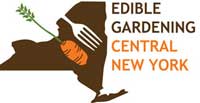Chasing Ice
"One of the most beautiful films of the year"
Mon., April 22 at 7:00 pm at The Palace Theater
|  |
This film has won 23 awards at film festivals around the world. Following the film, a Climate Impacts and Actions in CNY panel presentation will explore the documentary's environmental implications from a local perspective. The panel will consist of Dave Eichorn, syracuse.com meteorologist; Chris Carrick, Energy Program Manager for the Central New York Regional Planning and Development Board; and Yvonne Rothenberg, Founder of the CNY chapter of the Citizens Climate Lobby. Moderating the panel will be Chris Bolt, WAER news and public affairs director. Suggested donations: At the door: $10 Seniors/students: $5 Children 12 and under: Free For advance sale tickets, go to Greening USA. Free parking in rear of Palace Theater. |
Become a CommuniTree Steward
DEADLINE: 4/24
|  | |
Community members looking for a hands-on education and technical experience in urban tree management are invited to sign up for Cornell Cooperative Extension's CommuniTree Steward program.
Four in-class and field training sessions begin
May 1 at 6:00 pm.
Registration forms and schedules are online or contact CCE at 315-424-9485. |
Weekend Wildflower Walks at the Woods
April 27 and 28
2 - 3 pm |
 | | Trilliums |
| |
The premiere woodland wildflower garden at Baltimore Woods is a local treasure.
Join caretaker Audrey Loewer for a pleasant walk through one of the wonders of spring. Each week new species will bloom, and Audrey will reveal their past and present medicinal and culinary uses.
The garden is handicap accessible.
Meet at the Pavilion.
Donations appreciated.
|
| Edible Gardening CNY |  |
Sun., May 12, 2:00 pm at Liverpool Library TOPIC: Preserving your harvest, presented by John Allen and Hope Kuniholm Free and open to the public Learn more about edible gardening in CNY
|
Plantasia at Baltimore Woods
Sat., May 18,
8 am - 2 pm
(Members only - Fri., May 17, 4 pm - 7 pm)
|
 | | Goldenrod |
|
Available at the member's only event on Friday are free chestnut tree seeds ready for planting. Native plants, food, regional vendors and more! For more information, call 673-1350 or visit the website for more details.
|
| Our Habitat Garden |  |
Visit Our Habitat Garden website for information on providing habitat, earth-friendly gardening practices, plants, and various creatures here in Central New York.
|
HGCNY Officers
| |
| President:
Janet Allen
Vice-President:
Carol Biesemeyer
Treasurer:
Randi Starmer
Secretary:
Soule Leiter
Membership:
Linda Rossiter
Program Chair:
Carol Biesemeyer
Newsletter Editor:
Janet Allen
Additional Planning Committee Members:
Beth Mitchell
Dave Mitchell
John Allen
Peter Huntington
|
| HGCNY on Facebook |
As as more of us participate on our Facebook page, this will become a useful resource for asking (and answering!) local HGCNYers' questions about habitat gardening. |
|
Join HGCNY!
|  |
Becoming an official member of HGCNY is easy: just join Wild Ones! Basic household membership is $37/year, but there are other options, too. (See membership application or website.)
Wild Ones
P.O. Box 1274
Appleton, Wisconsin 54912-1274
Make checks payable to Wild Ones.
Or telephone toll-free 877-394-9453.
|
|
Our Edible Garden
|  | Visit OurEdibleGarden.org to see an example of a Central New York edible garden, the perfect companion to your habitat garden.
|
| Interested in Edible Gardening? | 
|
If you'd like to get information on Edible Gardening CNY, just email John to find out about edible gardening tours and monthly programs. Free and open to the public! |
|
Greetings!
 | Oblong-winged katydid
(Amblycorypha oblongifolia) |
Jim D'Angelo, Director of Sterling Nature Center, returns for our final regular program this year. In the past, he has presented programs on butterflies, bats, vernal ponds, dragonflies, and more. What this year? He'll talk about an especially important group of creatures: Insects: the good, the bad, the interesting and the unseen.
The program will start with the basics of insect identification and classification, and then we'll take a closer look at a few insects. We'll discuss a few of the "bad" insects, like the Emerald Ash Borer, that threaten our ecosystems. And then some of the many "good" insects that play vital roles in our environment, like the native pollinators, that need a bit of our attention. Lastly there are those insects we tend not to notice that have interesting roles in our ecosystems.
When: Sun., April 28 at 2:00 pm
Where: Liverpool Library ( Directions)
Free and open to the publicMonarch programs
I'll be giving presentations about Creating a Monarch Waystation and a Butterfly-friendly yard at the following times and locations: Tues. April 23 at 6:30 pm Fulton Public Library Sat. May 4 at 10 am at Baltimore Woods Nature Center Sat. May 4 at 3 pm at Beaver Lake Nature Center Wed. May 8 at 6:30 pm Liverpool Public Library Thurs. June 13 at 7:00 pm Dewitt Community Library
Other programs
I'll also be presenting a program on Habitat Gardening for Life.
Wed. May 22 at 6:30 at Northern Onondaga Public Library in Cicero.
 | | Green frog |
"Rescue frogs"If you have green frog tadpoles or young frogs in your swimming pool this spring, we can put them in our pond. We'd like only those that would otherwise die when pool maintenance begins. We can also take toad tadpoles, but not bullfrogs. Contact me if you have some. Thanks! Janet Allen President, HGCNY |
|
|
Habitat gardens benefit people, too
 | | Maidenhair fern |
Habitat gardeners know their yards benefit wildlife. They also enjoy their yards -- filled with life -- and find that they are a relaxing place to be.
And it isn't just their imagination! Science confirms the benefits of nature for people.
A new study from Scotland found that a simple walk in the park can ease "brain fatigue." This study was the first to measure brain activity by using a recently-developed portable EEG (rather than simply showing photos of nature, for example) and compared brain waves when people walked in urban areas and when they walked in natural areas.The results showed that when walking through urban areas, "their brain wave patterns consistently showed that they were more aroused and frustrated than when they walked through the parkland, where brain-wave readings became more meditative. While traveling through the park, the walkers were mentally quieter."The scientist concluded that "going for a walk in a green space or just sitting, or even viewing green spaces from your office window" was not lollygagging, but instead restorative. (And what better green space than our own habitat gardens!) Read more from the NY Times article...Birds help people living with dementia
Audubon's Together Green "Bird Tales" program reports that birds help people with dementia stay engaged and active.
Bird Tales encourages participants to connect with birds on a multisensory level -- sight, sound, smell, and touch. They improve the quality of bird habitat at each facility, incorporating practices like organic lawn care, landscaping with native species and setting up bird feeding stations.
See a 3-minute video and learn more about the program at Audubon's Bird Tales website.
|
|
About monarchs from the experts
Two of the world's foremost authorities on monarch butterflies are Chip Taylor (of Monarch Watch) and Lincoln Brower.
Chip Taylor
Yale's Environment 360 recently interviewed Chip Taylor about "Tracking the causes of sharp decline of the monarch butterfly." The monarch is at its lowest population ever.
Among the primary causes of decline, Taylor says, is the increased planting of genetically-modified crops, with the concurrent increase in herbicides, which kill milkweed, the only plant monarch caterpillars can eat.
When questioned whether gardens can make up for all the increased acreage of GM crops, Taylor said, "It's an Alice in Wonderland story of the Red Queen's race. You have to run as fast as you possibly can to stay in one place, and if you want to get any place, you have to run twice as fast. But I have to believe that we can have an impact if we get the gardeners in this country to help us out by planting milkweed and putting in native plants to stabilize native pollinator communities. So people now have another purpose for creating a garden. The purpose is conservation."Lincoln BrowerDr. Lincoln Brower was a guest on NPR's Science Friday on April 12. In addition to GM crops, Dr. Brower mentioned the change in the oyamel fir forests as an additional reason for the decline in monarchs. If you missed the interview, you can hear it on the Science Friday website. Excellent interview - don't miss it!
Wild for MonarchsAnd, of course, Wild Ones and HGCNY are also wild for monarchs! We're encouraging everyone to PLANT NATIVE MILKWEEDS and native nectar plants to try to save monarchs for the future. We need more Monarch Waystations! |
|
Hummingbirds @ Home
 | | Hummer with cardinal lobelia |
It's that time of year when we look forward to hummingbirds returning, and in fact, some people in CNY have already spotted their first hummer of the year.
Now the National Audubon Society has created Hummingbirds @ Home, a citizen science project. Here's how they describe it:
Recent science reports indicate that there is a mismatch between flowering times and the arrival of hummingbirds in their breeding areas. We don't know how this may be impacting the hummingbirds.
This program was developed to collect data on how hummingbirds interact with nectar sources so that we can begin to understand how hummingbirds may be impacted by changing flowering patterns and climate change. We also hope to gain insight into what, if any, effect human-supplied nectar feeders have on hummingbirds.
That's where citizens come in. We can help collect the large amounts of data necessary to find the answers to these questions, even while we're enjoying hummers in our yards.
This a spring-based program running until mid-June. It's not necessary to have a hummingbird feeder. You can participate with their smartphone or tablet app or with your computer.
Read more about Hummingbirds @ Home and watch the Tutorial video that explains how to participate.
|
|
Learning more about nature the high-tech way
 With mobile apps or just your computer, identifying plants and animals has never been easier. Here are just a few ways to get started: With mobile apps or just your computer, identifying plants and animals has never been easier. Here are just a few ways to get started:
LeafSnap
Want to identify a tree? With a new website and app, LeafSnap, an electronic field guide, will help you do it.
Leafsnap was developed by researchers from Columbia University, the University of Maryland, and the Smithsonian Institution. This free mobile app uses visual recognition software to help identify tree species from beautiful, high-resolution images of leaves, flowers, fruit, petiole, seeds, and bark. Leafsnap currently includes the trees of the Northeast and will soon grow to include the trees of the entire continental United States. BugGuide.net
Did you see an insect you'd like to identify? BugGuide.net is a great place to start. You can either explore the photos online or even submit your own photo. There's sure to be a volunteer who will be able to identify it -- often in just a few hours after submitting it. (It's hosted by Iowa State Univ., but run by volunteers.)
Discover Life
Their mission is "to assemble and share knowledge in order to improve education, health,
agriculture, economic development, and conservation throughout the world."
Pretty ambitious, but with the stellar group of dozens of prominent institutions and organizations, they're sure to succeed.
They provide free on-line tools to identify species, share ways to teach and study nature's wonders, report findings, build maps, process images, and contribute to and learn from a growing, interactive encyclopedia of life that now has 1,272,852 species pages with 607,348 maps. |
|
|
|
|